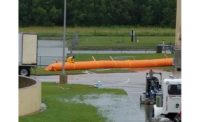
If an excavator dials 811 or a local one-call center before digging, damage to underground utility lines and the people who dig near them occurs less than 1% of the time, according to the 2010 Damage Information Reporting Tool Report released on Oct.12 by the Common Ground Alliance (CGA).
“A call to the one-call center or 811 is the simplest and most effective way to reduce or eliminate excavation-related underground-utility damages,” says Robert Kipp, CGA president.
The 2010 Damage Information Reporting Tool (DIRT) Report also estimates that the total number of incidents—defined as downtime, damages and near misses—could be reduced by 30% if all digging were preceded by a locate request.
It’s standard practice for Boh Bros. Construction, New Orleans, to call LA One Call 811 before any excavations, says Brian Callaway, the contractor’s regional health and safety manager. “LA One Call usually responds within 48 hours, and they come out and mark utilities or underground obstructions,” Callaway says. “If they don’t respond, we don’t dig. It’s never open for discussion. It’s part of our culture. We excavate so much and do so much underground work that it is second nature to what we do [to use the service].”
An estimated 165,000 underground-utility mishaps occurred in the U.S. in 2010, despite the 811 call center’s establishment five years ago. According to the CGA, that number is similar to incident rates over the past several years.
The leading causes for events include insufficient excavation practices (38%), notification not being made (32%) and insufficient locating practices (25%). The DIRT report also noted that small fencing, irrigation and landscaping contractors were most often involved in incidents resulting from a failure to notify a one-call center before digging.
CGA compiles its report from data that is voluntarily and anonymously submitted by damage-prevention stakeholders. This year’s DIRT study is CGA’s seventh annual report, and the organization attempted to “provide more meaningful takeaways for damage-prevention stakeholders” by creating a baseline figure that tracks changes in excavation activity and year-to-year progress, Kipp says.
The 2010 report features an increased emphasis on measuring damages per 1,000 one-call-center requests. Comparing this one-call-center data to incident data submitted from one-call centers in 31 state, CGA determined an average of 3.2 incidents occurred per 1,000 location requests last year.
“Our hope is that stakeholders use this report to improve their own data collection effort and better target their damage- prevention initiatives,” says Bob Terjesen, co-chairman for CGA’s Data Reporting and Evaluation Committee.
“The DIRT report makes some very concrete recommendations on how we can reduce the likelihood of damage when people dig,” Kipp says. “We are focusing our efforts on educating stakeholders about the report’s findings and how we can work together to ensure the safety of workers, underground facilities and the environment.”
The complete DIRT annual report for 2010 is available for download at www.commongroundalliance.com. Stakeholders interested in submitting data for the 2011 report or establishing a virtual private DIRT account should visit the DIRT site at www.cga-dirt.com.













